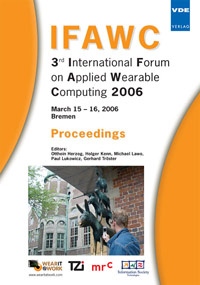Smart Networking Requests: Supporting Application Development Relying on Network Connectivity for Wearable Computers
Konferenz: IFAWC 2006 - 3rd International Forum on Applied Wearable Computing 2006
15.03.2006 - 16.03.2006 in Bremen, Germany
Tagungsband: IFAWC 2006
Seiten: 12Sprache: EnglischTyp: PDF
Persönliche VDE-Mitglieder erhalten auf diesen Artikel 10% Rabatt
Autoren:
Megen, Friedel van; Salmre, Ivo (European Microsoft Innovation Centre, Aachen, Germany)
Timm-Giel, Andreas; Görg, Carmelita (University of Bremen, tzi ikom, Bremen, Germany)
Inhalt:
In mobile and wearable computing the availability of communication networks changes over time and location in the same way as the requirements on communication from the application point of view change. Recent mobile and wearable devices support different networking technologies like UMTS, WLAN, and Bluetooth simultaneously and can use different networking protocols, such as infrastructure, ad hoc and MobileIP to extend coverage and support mobility. However, the complexity of managing these network functions increases dramatically, making it more and more difficult for application developers to control. Therefore within this paper a novel approach is presented providing a tool to the application developer, which allows to attach the business logic to Smart Networking Requests, ensuring the communication when a suitable network connectivity has been set up and possibly further requirements are met, such as a certain context (e.g. location) of the wearable computer. The approach presented is based on work achieved in the EC funded WearIT@Work project, which is an Integrated Project of the 6th IST Framework Programme. Within the WearIT@Work project the so-called Communication Service Module has been developed as part of the middleware, allowing to control the selection and configuration of the network connectivity by profiles only. This Communication Service Module has now been integrated into the Software Framework allowing the above addressed attachment of business and networking logic. A first prototype has been implemented proving the feasibility of the approach. Within this paper the main focus is on the requirements and conceptual design of the solution.


